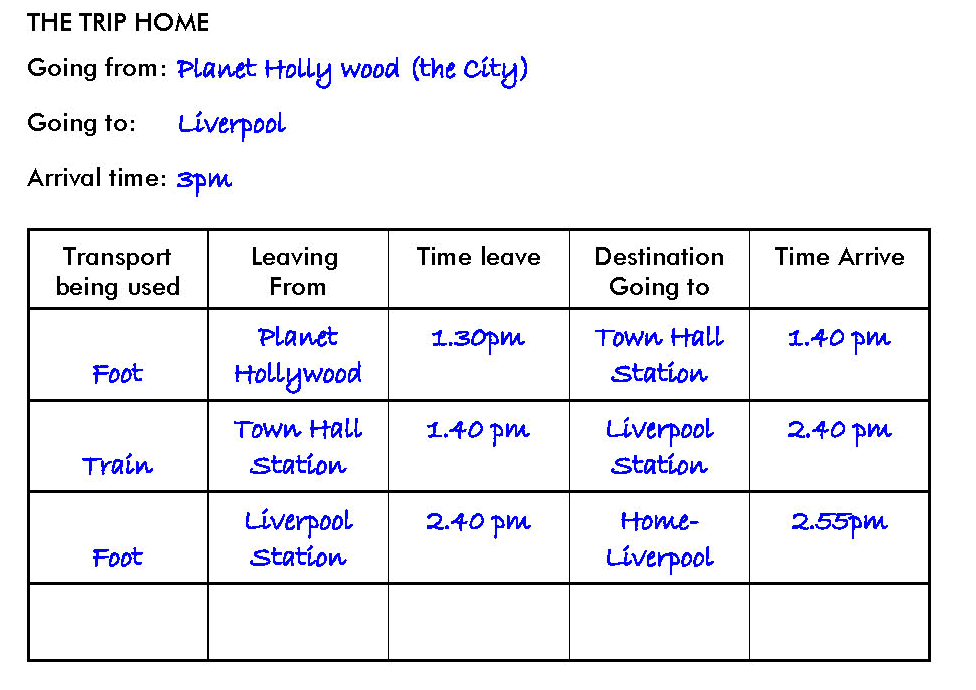- TOOL KITS
- A. The NEXT Step
- B. Promoting Independence
- C. Phone Apps
- D. Return to Work
- E. Motivational Interviewing
- F. Paediatric Brain Injury Rehabilitation Resources
- a) Introduction
- 0. Introduction
- 1. Working together promoting independence
- 2 . Using this kit
- b) Issues, goals, action
- 3. Identifying issues W
- 4. Setting goals W
- 5. Making goals happen W
- 6. Monitoring progress W
- c) Strategies Myself and my relationships
- 7. My behaviour's changed W
- 8. Thinking
- 9. Relationships W
- 10.Conversations
- Managing memory, money and time
- 11. Remembering information and messages
- 12. Finances and handling money W
- 13. Managing time W
- Household tasks
- 14. Food and shopping W
- 15. Food and meals W
- 16. House keeping
- 17. Laundry
- Getting around
- 18. Public transport W
- 19. Accessing the community
- Life tasks
- 20. Self care
- 21. Fitness
- 22. Leisure
- 23. Employment
- 24. Continue learning
- 25. Health and well-being
- Emergencies
- 26. Emergencies
18. Public transport and road safety
- 18.0
Public transport - 18.1
Catching a bus - 18.2
Catching trains - 18.3 W
Catching taxis - 18.4
Road safety - 18.5 W
Planning a trip
How do I get where I have to go?
If you need to go somewhere and have no way of getting there, you may have to use public transport. There are a number of different forms of public transport and you may need to use more than one sort to get where you need to go. The key to catching public transport successfully is to plan before you go! The following is information about how to catch a :
- Bus
- Train
- Taxi
- Road Safety
How do I catch a bus?

If you need to find out what buses or bus companies run in your area, then call 131500 on the phone and speak to an operator who will be able to tell you what bus to get on or what company to ring to find out what bus to get on. If you don't know what bus route to catch or what bus number to catch, then get a timetable and use this to plan when you need to catch the bus, where from and where it goes to.
Strategies for action
Before catching the bus:
Step 1: Know your destination.
Step 2: Open the bus timetable and locate your nearest stop.
Step 3: Check what day and time the bus runs, make sure you check AM and PM, weekday, weekends and public holidays.
Step 4: See what time the bus arrives at your destination and make sure it is the right time to get where you are going.
Step 5: Make sure you have enough money; If you have a concession card (for example, a pension card), remember to bring that too.
Step 6: Repeat the previous steps for your trip home.
When catching the bus:
Step 1: Be at the bus stop 5 minutes before the bus is due to come.
Step 2: When the bus arrives, check with the driver that it is the right bus and state your destination. This will affect how much fare you will pay. You may be entitled to a cheaper fare if you own a concession or pension card.
Step 3: Pay your fare and take a seat, near the driver if possible and where you can see where you are going so as to monitor the progress of your journey;
Step 4: Monitor your progress and when approaching your destination stop, signal the driver by pulling on the buzzer rope, pressing the bell or telling the driver to please stop at the next stop. Allow the driver enough time to stop!
Step 5: Stand and alight the bus. Don't stand till the bus has completely stopped. Otherwise there is a chance you may lose your balance and fall.
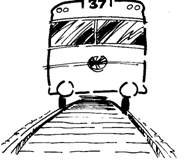
How do I catch a train?
Strategies for action
Before you catch the train:
Step 1: Know your destination and find out the closest station to were you are going
Step 2: Open the train timetable and locate your nearest station.
Step 3: Check what day and time the train you want to catch runs, make sure you check AM and PM, weekdays and weekends, and public holidays.
Step 4: See what time the train arrives at the closest station to your destination and make sure it is enough time to get where you are going.
Step 5: Make sure you have enough money
Step 6: Repeat the previous steps for your trip home.
Catching the train:
Step 1: Be at the station 10 minutes before the train is due so as to give you enough time to purchase your ticket and find the right platform.
Step 2: If there is a ticket window:
Purchase your ticket stating where you are going to and whether or not you require a return ticket. Remember to ask for concession if you are entitled.
If there is a ticket vending machine:
- Select your destination from a list of stations.
- Select your ticket. You have to push buttons to identify if it is a single or one way journey, a return journey, or if you are entitled to concessions.
- The screen will show you how much to pay. Pay this with coins, using the coin slot or use a note. The note can't be too creased or the machine won't accept it.
Step 3: Find the indicator board with all the stations written on it. Locate the destination station and it will tell you what platform the train leaves from and at what time.
Step 4: Go to the platform and wait for your train. Stand near an indicator board so when a train pulls up you can be sure it is your train as sometimes it may not be the train you want to catch. Check the indicator board before you get onto the train.
Step 5: When a train arrives that you are sure is your train, get on and sit as close to the doors as possible. Sit near a window so you are able to monitor your progress and you know when to get off.
Step 6: When you arrive at the destination station, get off the train and have your ticket ready to put through the machine or give to the State Rail Worker.
Helpful hints
Remember it is illegal to ride the train without a ticket. If a Transit Officer requests a ticket from you and you are unable to produce one you are liable to receive an on-the-spot fine. Apart from being publicly embarrassing it is also expensive and an unnecessary waste of money.
What do I do if I have to change trains?
Helpful hints
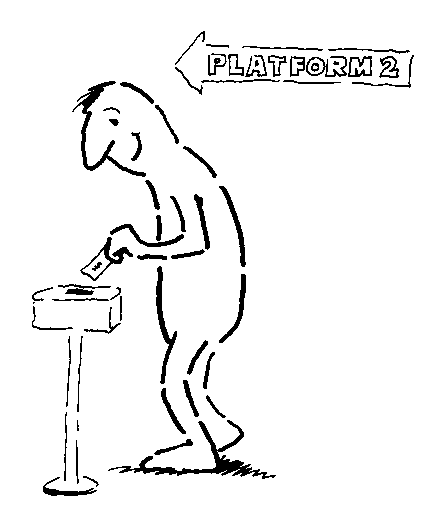
Remember, sometimes you may have to change trains to get to where you want to go. In this case, identify the common station where you have to change onto the other line. When you get to that station, find your last destination station and go to that platform. You will need to look at the train timetable to identify what stations are common stations. A common station is a junction. This is where train lines merge or come together. They then continue on a common line.
You only need to buy one ticket that indicates your final destination. You cannot break your train trip, without having to buy another ticket. For example, say you were traveling from Parramatta to North Sydney and you had to do shopping at Town Hall. If you purchased a ticket from Parramatta to North Sydney ...
- You would lose your ticket if you had to leave the station at Town Hall to do shopping. You will have to purchase another ticket to go from Town Hall to North Sydney.
- You would not lose your ticket if you were going to change platforms at Town Hall and continue on your journey.
What do I do if I miss my station?
Helpful hints
If you miss your station, get off at the next station that the train stops and find an indicator board that indicates the station that you were meant to get off at and go to the platform where it leaves. You catch the next train back to the station you were meant to get off at.
If you are not sure what to do, approach the State Rail Worker and ask for directions.
How do I catch a taxi?
Sometimes buses and trains just don't run where you need to go. You may need to get a taxi. Again, plan ahead, as you may need to book a taxi ahead of time to ensure it arrives in the appropriate time.
Strategies for action
Step 1: Find the telephone number of a local taxi service. Write this number down.
Step 2: Ring the number given to you and tell the operator that you would like to book a taxi.
Step 3: Give the operator the details they ask for, for example the address you will be waiting at to be picked up, what time you want the taxi to be there and the destination. You may also want to book a taxi for the way back at the same time.
You will need to let them know if you require a taxi that has wheelchair access. You may qualify for cost assistance if you cannot get around by public transport. To find out if you do qualify contact the brain injury unit who can help you find out this information.
Step 4: Ensure you have enough money as taxis are more expensive than other forms of public transport.
Step 5: When the taxi arrives, it may just toot its horn so be ready at the time you booked the taxi for.
Step 6: Tell the driver the specific destination. You pay at the end of the trip.
What if my taxi does not turn up?
Helpful hints
If the taxi does not arrive, call the number you booked the taxi through and tell them the taxi has not arrived. They will tell you what to do.
Gemma's experience
Gemma uses public transport to visit family who live on the other side of the city and to visit the Brain Injury Rehabilitation Unit at Liverpool. Gemma sits on the entry level of the train and sits in the carriage near the Guard's compartment.
Gemma will use trains over buses because of the big steps you have to climb to access the bus. Gemma is OK using normal height steps but not large ones, like on buses.
At night Gemma chooses to catch taxis. Although they may be more expensive, she likes the safety they provide. When Gemma uses public transport she doesn't like having to walk alone from the drop off point or the station to her home, so she uses a taxi, which provides door-to-door service.
An example of how Gemma works out how to allow enough time when using public transport follows Worksheet 16. The example shows Gemma traveling from Liverpool to the city to meet some friends for lunch.
Helpful hints
To enable you to plan your public transport trips accurately use Worksheet 16 to plan your trips.
How can I make sure I am safe crossing the road?
Helpful hints
When moving around in the community, you will have to cross roads and be aware of road safety. Here are some helpful reminders for road safety.
• If there is a crossing, lights or a pedestrian crossing near where you want to cross, cross at the crossing.
• Walk on footpaths not on the side of the road.
• If there are no crossings where you want to cross, make sure you look to the right and look to the left then look to the right again. If the road is clear of traffic, walk straight across the road. Keep looking for cars as you cross the road.
• When crossing at lights, make sure you press the button to cross and don't cross until the green man or walk sign tells you it is safe to do so. Don't cross if there is a red man or don't walk sign- even if it is flashing.
• When you cross at a crossing, always keep looking in case cars do not stop
• Do not walk out behind or in front of stationary buses or vans as you cannot see what is coming and oncoming traffic cannot see you. Wait until the bus or van has moved on.
• Use pedestrian bridges if present to cross busy roads.
• Do not jump fences or partitions on the median strip or on the side of the road. They are there to stop people crossing there, as it is dangerous
• Be aware that at night drivers are less likely to see you crossing so be extra cautious when crossing the road.
• Don't assume that drivers will see you crossing and stop or slow down as some don't. Treat all drivers as if they haven't seen you.
• Take care stepping from the curb to the road. If you have an unsteady gait or use a walking aid or wheelchair, use the ramp section to access the road.
If you are not sure if it is safe to cross, don't! Find a safe crossing whether it be a crossing at lights or an area where you can see traffic corning both ways. It is worth walking the extra distance, otherwise you run the risk of being hit by a car, van, bus or truck.
Who can help me to use public transport?
Brain Injury Rehabilitation Unit Occupational Therapists.
Worksheet 16 can be used to plan the transport for a trip.
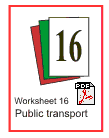
Here is an example of a trip to the city for lunch.
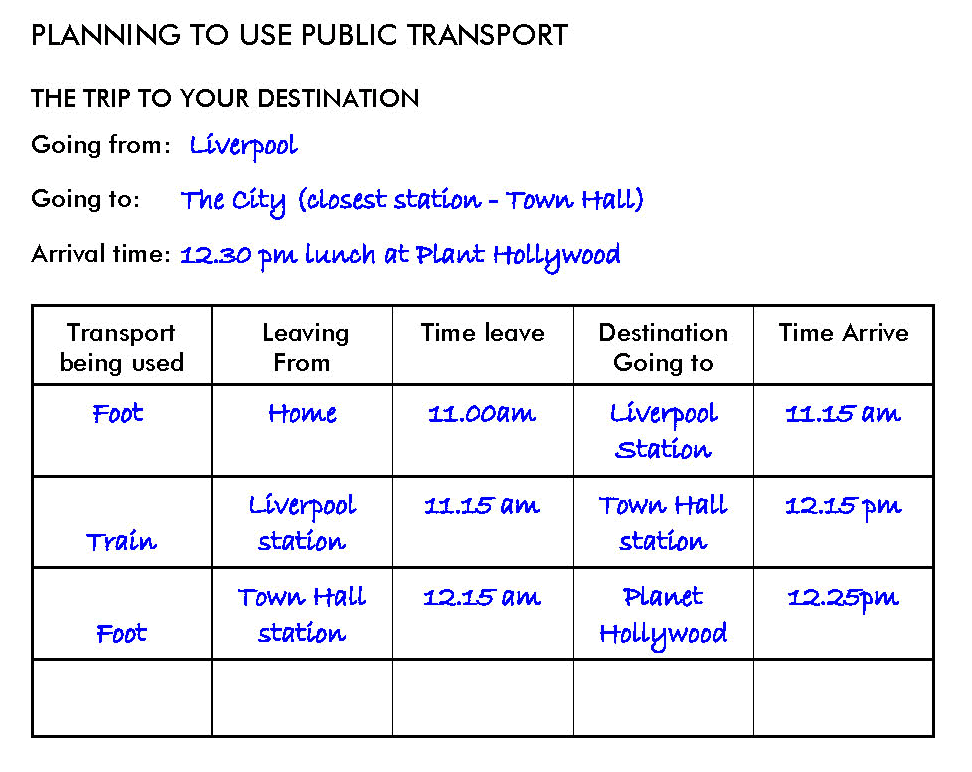
Here is an example of the trip back home.
